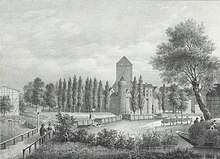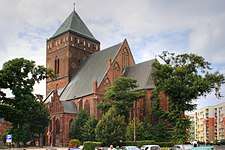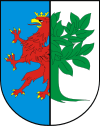Goleniów
Goleniów [ɡɔˈlɛɲuf] (Kashubian: Gòłonóg; German: Gollnow) is a town in Pomerania, northwestern Poland with 22,399 inhabitants (2004). It is the capital of Goleniów County in West Pomeranian Voivodeship (since 1999); previously it was in Szczecin Voivodeship (1975–1998). Town area is 12.5 square kilometres (4.8 sq mi), geographical situation 53°33'N and 14°49'E. It is situated in the centre of Goleniowska Forest on Goleniów Plain, near main roads numbers 3 and 6. Nearby town-part: Helenów
Goleniów | |
|---|---|
.jpg) Medieval defensive walls | |
 Flag  Coat of arms | |
 Goleniów | |
| Coordinates: 53°33′49″N 14°49′41″E | |
| Country | |
| Voivodeship | West Pomeranian |
| County | Goleniów County |
| Gmina | Gmina Goleniów |
| Established | 10th century |
| Town rights | 1268 |
| Government | |
| • Mayor | Robert Krupowicz |
| Area | |
| • Total | 11.74 km2 (4.53 sq mi) |
| Elevation | 15 m (49 ft) |
| Population (2011) | |
| • Total | 22,844 |
| • Density | 1,900/km2 (5,000/sq mi) |
| Time zone | UTC+1 (CET) |
| • Summer (DST) | UTC+2 (CEST) |
| Postal code | 72-100 |
| Area code(s) | +48 91 |
| Car plates | ZGL |
| Website | http://www.goleniow.pl |
The international airport Szczecin-Goleniów "Solidarność" Airport is located just East of the town.
History
The settlement dates back to the 10th century. Together with Pomerania it formed part of Medieval Poland and as a result of the 12th-century fragmentation of Poland it became part of the separate Duchy of Pomerania, ruled by the House of Griffin. Barnim I, Duke of Pomerania granted the settlement Madgeburg town rights and additional privileges in 1264, yet the town was rechartered with Lübeck Law, which favoured the local merchants, in 1314.[1] The town grew by exploiting the vast timber reserves in the town-owned forests, and by trade.[1] Gollnow was connected to the Baltic Sea trade routes by the port of Inoujście at the mouth of the Ina river.[1] Competition with nearby Stettin (now Szczecin) led to a series of conflicts between the two towns, the differences were set aside only in 1615 when the towns signed a reconciling treaty.[1] The town remained part of the Duchy of Pomerania until Sweden took over in 1630.

The Thirty Years' War devastated the town, and as a consequence of the post-war Peace of Westphalia (1648) and Treaty of Stettin (1653), Gollnow remained with Sweden who had occupied the area since the Treaty of Stettin (1630).[1] The border with Brandenburg-Prussian Pomerania now ran close to the town, and cut Gollnow off from its economic hinterland, which hindered recovery from the war.[1] Between 1677 and 1683, Gollnow was occupied by Brandenburg-Prussia.[1] In the years that followed, the number of craftsmen in the town grew steadily.[1] In 1720, Sweden lost her possessions south of the Peene and east of the Peenestrom rivers, including Gollnow, to Prussia in the Treaty of Stockholm. In the 19th century, craft and trade were joined by industry - Gollnow hosted a coppersmith, a needle fabrication, several facilities for the manufacturing of furniture, three breweries, a distillery, and five water mills.[1] In the late 19th and early 20th century, Gollnow became an important railroad junction, when it was connected to Neudamm and Naugard in 1882, to Cammin and Wollin in 1892, and to Massow in 1903.[2] Gollnow was part of the Prussian province of Pomerania from 1815 to 1945. Before 1945 it was also part of Germany. During World War II, Polish forced labourers were imprisoned in the town. The totality of the town's population was expelled.
On 7 March 1945, the town was captured by the Red Army. After Nazi Germany's defeat in World War II, the area became part of Poland.
Population
1745: 1,677 inhabitants[1]
1796: 2,200 inhabitants[1]
1811: 2,929 inhabitants[2]
1828: 3,920 inhabitants[2]
1843: 4,911 inhabitants[2]
1864: 7,413 inhabitants[2]
1895: 8,181 inhabitants[2]
1910: 10,258 inhabitants[2]
1928: 11,815 inhabitants[2]
1938: 13,500 inhabitants[2]
1960: 10,300 inhabitants
1970: 14,700 inhabitants
1975: 17,200 inhabitants
1980: 19,100 inhabitants
1990: 22,200 inhabitants
1995: 22,200 inhabitants
2004: 22,399 inhabitants
2007: 22.399 inhabitants
2008: 22.377 inhabitants
2011: 22.844 inhabitants
International relations
Goleniów is twinned with:
Towns near Goleniów
- Szczecin City (Poland)
- Police, Poland
- Stargard (Poland)
- Maszewo (Poland)
- Nowogard (Poland)
- Kamień Pomorski (Poland)
- Wolin (town) (Poland)
- Golczewo (Poland)
Tourist villages near Goleniów
Notable people

- Johan Frederik Clemens (1749–1831), a Pomeranian-Danish printmaker in etching.
- Werner Kollath (1892–1970), a German bacteriologist, hygienist and food scientist.
- Günther Marks (1897–1978), a German church musician, organist and composer
- Helga Paris (born 1938), German photographer
- Marek Leśniak (born 1964), a retired Polish footballer, played over 500 pro games and 20 for Poland
- Grzegorz Stępniak (born 1989) a Polish professional racing cyclist
- Tom Swoon (born 1993), DJ, remixer and record producer
References
- Peter Oliver Loew, Staatsarchiv Stettin: Wegweiser durch die Bestände bis zum Jahr 1945, a translation of Radosław Gaziński, Paweł Gut, Maciej Szukała, Archiwum Państwowe w Szczecinie, Poland. Naczelna Dyrekcja Archiwów Państwowych, Oldenbourg Wissenschaftsverlag, 2004, p.286, ISBN 3-486-57641-0
- Peter Oliver Loew, Staatsarchiv Stettin: Wegweiser durch die Bestände bis zum Jahr 1945, a translation of Radosław Gaziński, Paweł Gut, Maciej Szukała, Archiwum Państwowe w Szczecinie, Poland. Naczelna Dyrekcja Archiwów Państwowych, Oldenbourg Wissenschaftsverlag, 2004, p.287, ISBN 3-486-57641-0
External links
| Wikimedia Commons has media related to Goleniów. |
| Wikisource has the text of the 1911 Encyclopædia Britannica article Gollnow. |
- Official town website
- Jewish Community in Goleniów on Virtual Shtetl
- Satellilte photo via Google Maps


_w_Goleniowie.jpg)

